-
Article
tells you about the origin of Kalighat paintings, its making and materials
used, variety - global influence, innovations, photography and kalighat
paintings and women in these paintings.
“Beauty
lies in the eyes of the beholder” as Plato had once said and it holds true for
Kalighatpatachitra.
Kalighat
paintings developed in the mid-19th century in Kolkata (formerly Calcutta) to
illustrate Hindu gods and goddesses and respond to topical social and political
events affecting the local people.
At
that time, many Patua artists - itinerant storytellers who travelled from
village to village, slowly unrolling and singing from scrolls in exchange for
food and other goods - migrated to Kolkata because selling their illustrated
Kalighat paintings gave them a more secure income.
In
contrast to the linear narrative style of the scrolls, Kalighat paintings
depict a single scene with graphic, simplified forms and often satirical,
contemporary content.
As
cheaper wood prints and then machine-printed images became more desirable to
tourists visiting Kolkata, Kalighat painting declined.
The
scroll painters from West Bengal who opened shops in Kalighat district and
began painting religious subjects in the Kalighat style also became known for
their satirical portrayals of Kolkata society - English sahibs riding elephants,
wealthy Calcutta babus (liberalists) immorally squandering wealth, and
charlatan sadhus (holy men) succumbing to base desires.
Background
The
earliest form of art in Bengal was done on cloth or patas and even paper scrolls depicting scenes from Hindu
religious epics like the Rama Charita Manas. In order to increase the
customer base for their art form, the patuas moved to the urban
center of Calcutta.
Their
move to settle around the temples, especially Kalighat Temple, was
deliberate because this is where the themes of their art were most appreciated.
Since Kalighat Temple was a popular religious destination, people
would buy Kalighat paintings during their regular visits. During
festivals, the painters would create paintings with a special theme, which was
again very popular with the temple goers.
The
specific genre of Kalighat paintings is believed to have originated
around 1850 in India.
There
was no separate community of artists and artisans that were invested in the
creation of the Kalighat paintings. These paintings, in fact, were made by
artisans of different professions such as potters, stoneworkers, and
carpenters.
Simultaneously,
Calcutta was slowly undergoing changes in its education system under the
British rule and had begun to recognize fine art as a mainstream field of
study. This motivated artists to move to the city and learn newer techniques
and appreciate modern themes, the influence of which can be seen in later Kalighat paintings.
Hence
emerged two different styles of the Kalighat painting, the Oriental,
and the Occidental, both of which were popular in the country.
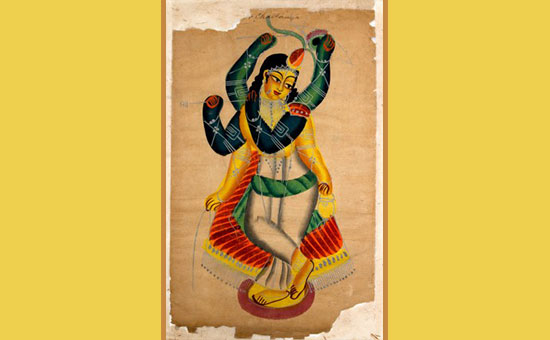
Materials Used
Although
it is obvious that there would have first been a sketch and an outline and
eventually the filling of the motif, it is interesting to learn about the
unconventional tools used to make these paintings.
Squirrel
and goat hair was used to make the brush that was used for sketch drawings. The
black ink used for this purpose was made using soot produced by burning an oil
lamp under a pot. The other vibrant colors used for filling the painting were
essentially homemade in the form of either vegetable dyes or powdered stone
fragments of different colors. The dry colors would be mixed with either gum or
water to create paint fit to be used on paper and textile.
With
the onset of industrial revolution in India however, the colors that were used
were industrially produced along with the canvas.
The Making
Due
to the era in which Kalighat paintings were born, they were created
with natural dyes and on easily available materials such as cloth and scrolls.
What is interesting about the Kalighat paintings is
that an entire family would be involved in the creation of the piece.
Each
member of the family had a particular task in the creation process, based on
sex and age. Economically, this translated as being one of the biggest cottage
industries in West Bengal at the time.The women and children in the family are
responsible for grinding the colors and creating the dyes. Other
responsibilities included marking the outline in pencil and generally making
all preparations for the painting.
The
first of the artists would copy only the outline of the sketch onto the canvas
from the model sketch.
A
second artist would then draw and color the contours of the figures, as they
were always human figures. The flesh would be depicted in a lighter shade than
the muscles.
The
last, among the artists, would fill in the surrounding colors in the motif as
well as the backdrop along with the final outline done in black.
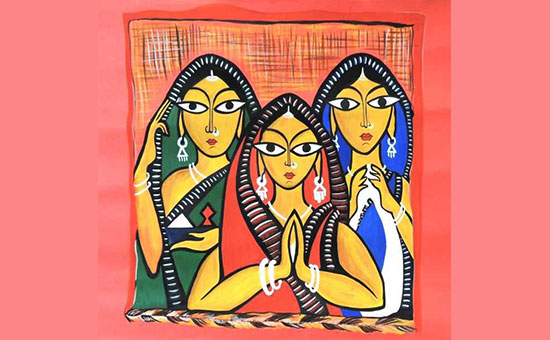
Variety
The
main distinguishing facet of the Kalighat paintings is the motifs
used in them. Because of this there are two types
of Kalighat paintings that one can witness, Oriental and Occidental.
The
Oriental Kalighat paintings depict gods, goddesses, mythological
characters as well as scenes from religious Hindu texts. Some of the most
popular motifs from this type include Rama-Sita, Radha-Krishna, goddess Durga,
goddess Laksmi, goddess Annapurna, Hanuman, Shiva and Parvati, among others.
The
other more contemporary style of Kalighat paintings are the
Occidental variety that feature secular and civil themes like crime, women
bathing, the evolving role of men and women in the society since the emphasis
on women’s education, the hypocritical lives of the quasi-bourgeois, depictions
of the freedom struggle, heroes of the struggle including Rani Lakshmi Bai, a
girl playing the sitar and other themes that common people could identify with.
In
this sense, Kalighat paintings were way ahead of their times and
influenced a lot of critical thinking in those that appreciated this art form.
Besides
motifs, Kalighat paintings feature the use of basic colors like
indigo, blue, black, yellow, red and green due to the predominant use of
homemade dyes. Only for ornamentation would artisans use silver and gold.
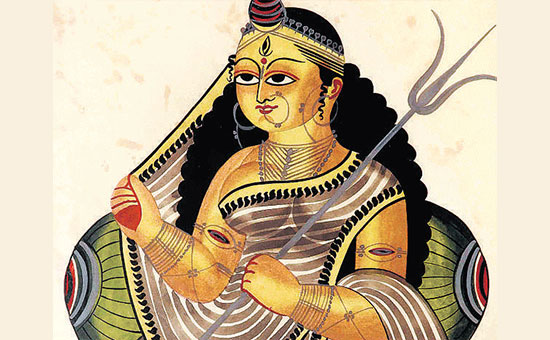
Present Day Scenario and Global Influence
Kalighat paintings
are now on exhibit across the globe, right from Britain to Prague and Philadelphia.
It is one of the most well recognized forms of Indian modern art globally.
Besides
being an art form, it is also used as a modern motif in the creation of
fashionable ethnic Indian garments. Indian designers have been inspired by this
genre of art to create some of the most unusual motifs to have ever been
spotted on a saree. This, however, has played a great role in widening the
scope of its reception and bringing it to younger people whose interest lies
more in unique fashion than in modern art forms.
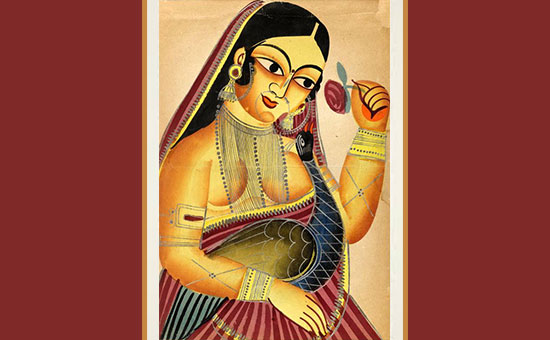
Innovations
Kalighat paintings
also saw a diversification in the motifs or subjects for their paintings. Pets
and other animals such as cats, fish, lobsters, prawns, birds etc. were also
used as primary subjects in a string of Kalighat paintings.
Experts
say, that this shift in theme could have been influenced either by
the Mughal fascination with fauna or with British, and by extension
Western, interest in modern themes.
Photography & Kalighat Painting
Photography
and Kalighat painting were rival professions in the expanding metropolis of
19th century Kolkata. Both pay attention to current affairs, or to capturing a
moment within the artist’s surroundings.
Kalighat
painting flourished from the early 1800s for almost a century, but fell into
decline after the advent of the more easily reproducible lithograph and
photograph. Eventually, the children of Kalighat painters migrated to other
professions, and the last Kalighat painter is reported to have died in 1930.
Patua
has created a number of works and series about photography and the associated
ideas of self-representation.
Women in Kalighat painting
Women
are often represented by trees in Hindu iconography, as they symbolise shelter,
fertility, growth and possibility. Because Kalighat painting originated near
the temple of the goddess Kali, female subjects are often shown as strong, in
her honour. Kali embodied Shakti
-
the female active principle of Hindu philosophy.
Women
are also idolised as goddesses, such as Saraswati the goddess of knowledge and
the arts, rather than being portrayed as objects of desire. In contrast, male
suitors are often satirically portrayed as ‘lap dogs and charlatans’.

Conclusion
Today
the practice of Kalighat paintings still continues in the villages of Bengal
where the rich traditions are proudly being carried out by
the patuas which are being handed down through the generations.
This
is surely a matter of great appreciation and a consortium is needed whose
un-tired effort will revive the glorious past of Bengal.
“Simplicity
is the ultimate sophistication”. Remembering the quote of Leonardo da Vinci.
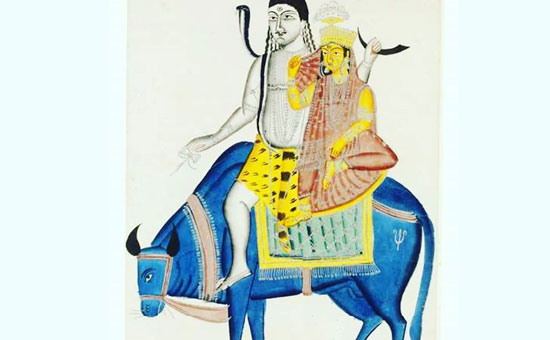
Facts and Trivia
Kalighat paintings
have said to influence modern artists like the late Jamini Roy.
The
largest collection of Kalighat paintings is not in India, but rather
in the Victoria & Albert Museum in London.
The
earliest Kalighat paintings were made on long scrolls and the
artisans would sing songs related to the theme of the painting in order to sell
them.
The
customer base for the Kalighat paintings increased and in the 19th
century expanded to include traders and merchants from Western parts of the
country.
Many
Western art scholars have studied the Kalighat paintings and made an
effort to interpret them. However, many of them got the plots wrong and the misconceptions
were dismissed only about two decades ago.
Author is a Mumbai based artist.
The
purpose of this compilation is to document and promote. We have given credits
and reference links in this compilation. In case some are missed, it is not
with malafide intent.
To read all
articles by author